Do-it-yourself gas stove repair: common faults and how to fix them
Even if you purchased the most expensive gas stove, the manufacturer makes absolutely no guarantees that it will not break after several years of use. Agree, spending additional money on repairs that you can do yourself will be somewhat inappropriate.
Unlike repairing the same washing machine or refrigerator, you can fix a breakdown of a gas stove yourself, after first understanding the structure of the device. Since working with gas equipment always requires extreme caution, before you start repairing a gas stove with your own hands, you should take all safety measures.
The breakdown of a gas stove can be associated not only with contamination of the nozzles, which means that in some cases it will be necessary to replace faulty parts. During operation, the oven door mount may break or the electric ignition may fail, so later in the article you will be able to familiarize yourself with the most common breakdowns of a gas stove, and consider in more detail the sequence of their elimination.
The content of the article:
Common gas stove breakdowns
According to the rules for the safe use of gas appliances, all repair work must be carried out by a qualified gas service specialist. In case of serious damage to the gas stove, the consumer is obliged to contact the company with which he entered into maintenance contract gas equipment.
However, this applies to extremely difficult situations where any unauthorized intervention in the operation of gas equipment can endanger all residents of the house.
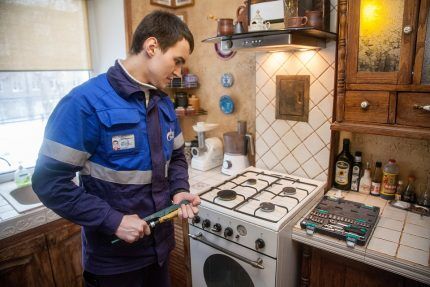
If the malfunction of the gas stove was not due to a leak of blue fuel, then there are very real chances to make repairs without the help of a specialist.
Some of the most common problems that you can deal with yourself include:
- lack of flame when lighting individual burners;
- failure or clogging of the electric ignition;
- unstable functioning of gas control;
- broken oven door fasteners;
- tight turning of the gas valve.
Before repairing a gas stove, be sure to shut off gas access to the room, even if the breakdown has nothing to do with the problem of fuel supply. As an additional safety precaution, it is better to open the window or front door slightly.
Gas workers strongly recommend completely turning off the piezo ignition during repairs, so that in case of accidental damage to gas equipment it does not provoke an explosion.
Gas stove repair
Before you start repairing a gas stove, you should familiarize yourself with it structure and operating principle. If the problem is a clogged burner nozzle or a faulty piezo, then to carry out repairs you will need to remove the top panel. Before disassembling the gas stove, it is necessary to completely turn off the gas system by turning off the corresponding tap on the pipe and turning off the electricity supply.
Next, remove all the bolts connecting the top panel to the control panel. They are located under the burners, so first you need to remove all four burners. To remove the top panel, you will have to make some effort to release it from the clamps.
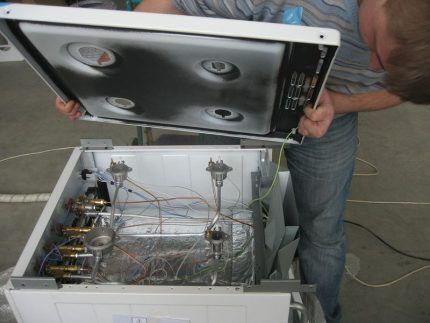
Having successfully removed the top panel, we proceed to dismantle the control panel. First of all, remove all the handles from the stove and unscrew the bolts. Often these bolts are located at the bottom, although depending on the model they may be in different places.
If all connecting elements have been safely removed, we begin to pull the panel, simultaneously pulling out the buttons and pressing the clips to the body. With very little effort, you can quickly remove both panels and proceed directly to diagnosing the device.
Failure No. 1 - burner clogged
Interruptions in the operation of the burners are the most common breakdown of a gas stove, which you can quite realistically handle with your own hands. In this case, when the burner is lit, the flame may burn very weakly or disappear altogether.
Such situations arise due to clogging of the divider or nozzle, which occurs as a result of careless operation of the equipment. During the cooking process, food or fat residues may get inside the nozzle, which is why the burner may not ignite at all.
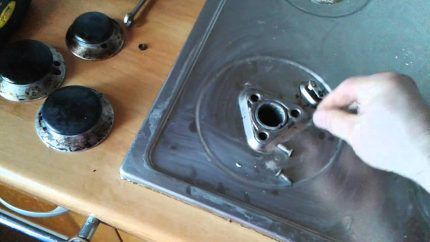
In this case, the only option is to clean the nozzle with a wooden toothpick, having previously sharpened it with a regular stationery knife.
If you want to clean the nozzles as best as possible, then the best option would be to unscrew all the bolts and open the lid of the gas stove, but this must be done very carefully so as not to damage the device. To more effectively clean the nozzle, it is recommended to unscrew it first.
Another problem that owners of gas stoves may encounter is the noise made by the burner during operation. Read how to deal with such a situation Further.
Failure No. 2 - problems with electric ignition
The electric ignition function in gas stoves greatly simplifies life for the modern user, but it does not always work properly. To identify the exact cause of the breakdown of the piezo element, you should first of all find out whether the reason for the lack of flame on the burner is really a malfunction of the piezo element.
Check for contamination on the surface of the ignition elements. Even if a small drop of water gets inside the nozzle, the burner will no longer ignite.
In the case when only one burner does not work, it makes sense to check its ignition electrode. If there is a crack on its surface, then the problem of the lack of flame lies precisely in it. The spark simply shoots to the side, not reaching the burner divider.
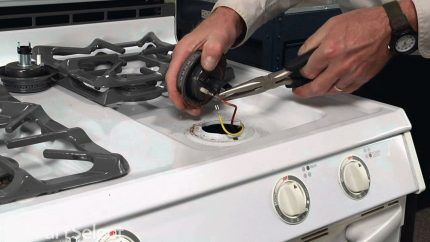
Before starting repairs, you must remove all burners and open the stove lid. If, when you press the electric ignition button, a spark does not jump out only in one burner, then the reason is a malfunction of the spark plug (electrode), on which a crack has formed.And only if all the burners do not light up, most likely the problem lies in a damaged wire connecting the piezo and the electric ignition unit.
After removing the top panel of the gas stove, press the ignition button, which will help determine the cause of the electric ignition malfunction. If the wire is actually damaged in some place, then you will see a spark jumping at the point of damage.
Regardless of how the breakdown occurred, due to a crack in the electrode or damage to the wire, there is only one way to repair the automatic ignition of a gas stove - replace the broken part with a working one.
Failure No. 3 - gas control does not work
Any gas stove is equipped with a special gas control system, which provides control over gas leaks during operation of the equipment. This system is called a thermocouple, and looks like a small metal pin located near each burner.
Even if the flame goes out for some reason, the thermocouple does not allow the gas to spread, and therefore prevents an emergency situation from occurring.
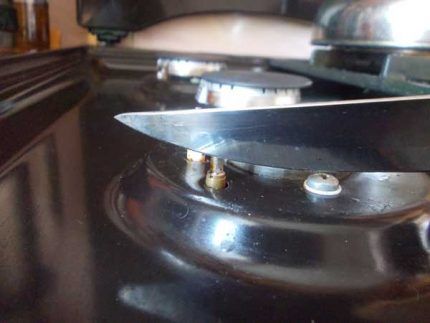
The gas control element may fail due to a simple blockage that can form during operation of the equipment. In this case, it is enough to clean the thermocouple from accumulated grease and dust using simple sandpaper.
If even after cleaning the element, the gas stove burner still goes out, you will have to repair the gas control yourself by disassembling the panel and installing a new thermocouple.
Failure No. 4 - door failure
The most common oven problem is the inability to close the oven door completely. Such a malfunction can occur as a result of excessive load on the door itself, which is why it is not recommended to place heavy objects on it, for example, frying pans, baking sheets.
Over time, the brackets needed to hold the door simply become deformed, causing them to no longer perform their function.
You can carefully inspect the brackets of the gas stove and assess the degree of their deformation only after the appliance door has been completely disassembled. To do this, you will need to open the door, bend the hinges on both sides, and then carefully close it all the way. Next, you need to slowly pull the door towards you, simultaneously moving it up, and disconnect it from the stove.
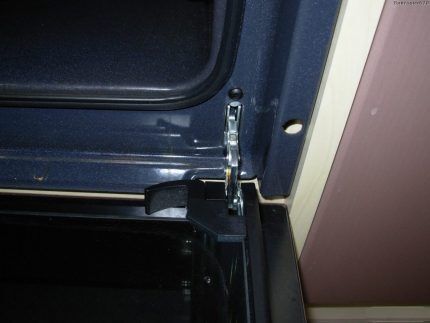
Next, remove the side panels of the oven, under which the brackets responsible for pressing the door are “hidden”. If the part is deformed in different places, then it is better not to waste time restoring its shape, but simply purchase a suitable bracket for the corresponding model of gas stove.
Today, on numerous websites of specialized online stores, you can easily select the necessary part for any gas stove, including outdated models from domestic manufacturers. If you fix a deformed bracket yourself, there is no guarantee that the part will not break in the near future after repair.
Failure No. 5 - the tap is difficult to turn
If the gas stove tap does not turn well, you can return it to normal operating condition by lubricating it with a simple graphite lubricant. The first thing you need to do is turn off the central gas supply valve to the stove, and then remove the top panel to provide access to the valves.
At the faulty faucet, unscrew the two shank screws and take out the bronze plug, which must be wiped with a soft rag.

Next, dip your finger into the graphite grease and apply it to the tap plug, but you will have to do this with extreme caution so that excess grease does not get into the tap hole.
If the gas stove tap is not damaged, but simply turns tightly, then other than the usual lubrication of the plug, serious repairs will not be needed.
We also recommend reading our other article, where we talked in detail about how increase the power of the gas burner.
Conclusions and useful video on the topic
You can learn how to solve the problem of interruptions in the operation of the thermocouple of a gas stove from this video:
A step-by-step repair of the oven door is presented in the following video:
A breakdown of a gas stove usually brings a lot of inconvenience, but it does not always require the help of a qualified specialist. If you completely disconnect the device from the gas supply and electricity, then any owner can independently repair the gas stove.
The article presented the most common malfunctions of a gas device, as well as ways to eliminate them without the help of a specialist.In this case, it is important to diagnose the equipment, and only then begin repair work. But if you are not confident that you can cope with the breakdown yourself, it is better to seek help from specialists.
If you have already encountered the presented gas stove breakdowns, and at the same time you had to repair the broken part yourself, share your experience with our readers by leaving a comment immediately after the article. Tell us about the difficulties that arose during the process of repairing equipment, and whether you managed to cope with them.



